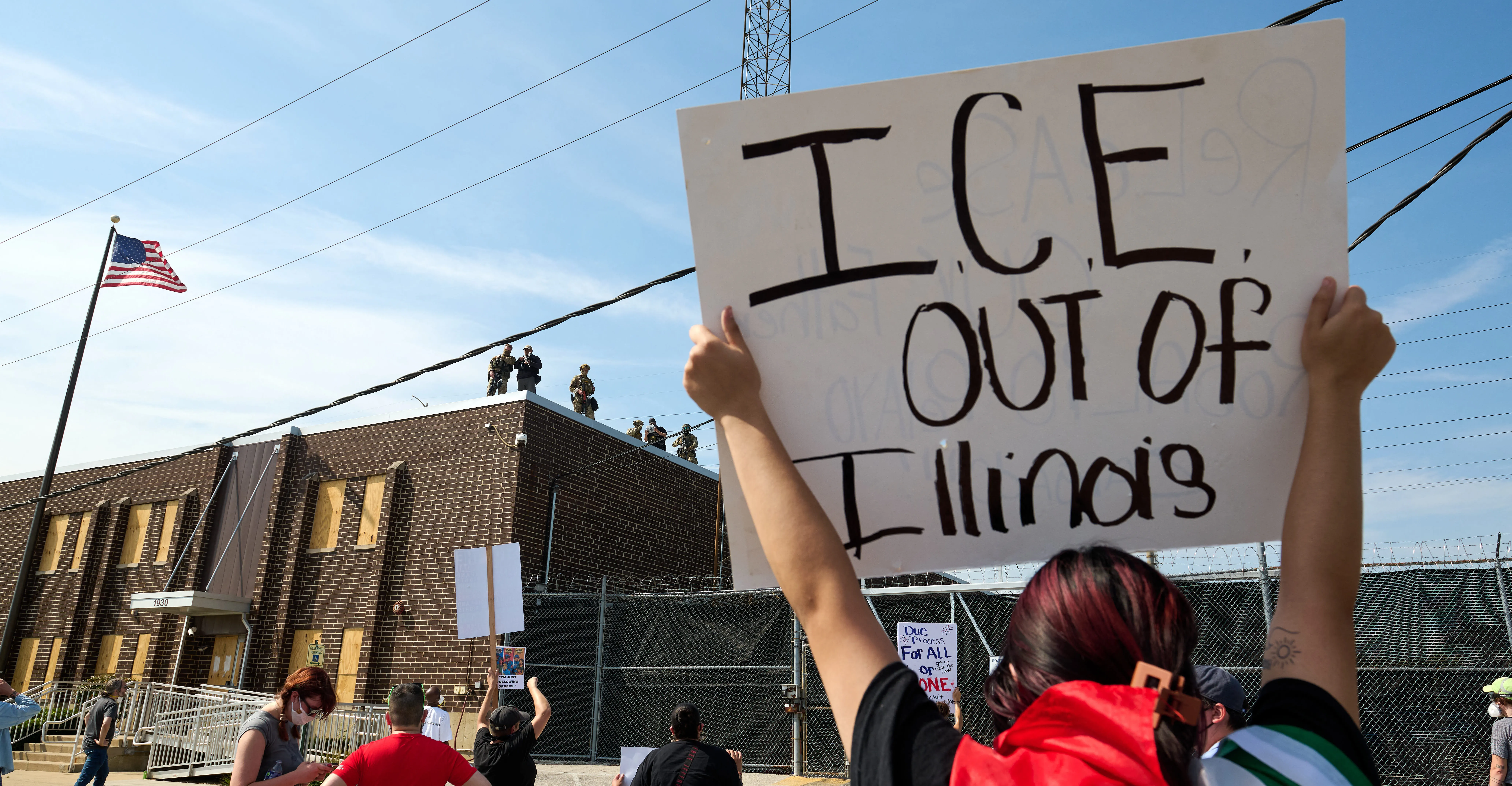By Christian Paz
Copyright vox

When a shooter opened fire on an immigration facility in Dallas last week, killing at least one migrant detainee in the process, it fit into a recent pattern of escalating tension — and violence — that has increasingly defined President Donald Trump’s mass deportation campaign.
At the center of this growing strain is one agency in particular: the United States Immigration and Customs Enforcement agency, which has been deputized to carry out Trump’s anti-immigrant directives across the nation.
The Republican response to the Dallas shooting was uniform: They condemned it as the latest example of left-wing inspired violence against law enforcement. Politicians, activists, and commentators rushed to count it as evidence that Democrats specifically were “inciting” aggression against ICE, aiding criminals, and hampering Trump’s agenda. “This violence is the result of the Radical Left Democrats constantly demonizing Law Enforcement, calling for ICE to be demolished, and comparing ICE Officers to ‘Nazis,’” Trump posted on Truth Social. The White House then released a list of Democrats’ criticism of ICE, calling their words “a battle cry for violence.”
Democratic responses, meanwhile, were splintered. Most national Democrats have remained quiet — including candidates running in competitive battleground races like Sen. Sherrod Brown in Ohio and former Gov. Roy Cooper in North Carolina, and progressives in Congress. House and Senate leadership condemned violence against law enforcement, while Texas Democrats said, “no one — those in uniform, civilians, or immigrants — should be subject to the senseless violence.”
There are plenty of reasons more Democrats haven’t spoken up — many details are still unknown. But this split in reactions reflects a deeper divide between the parties and among Democrats. Republicans are all-in on ICE, while Democrats are coming to realize that they need to decide what to say, and what to propose to do, about the agency.
This debate stands to explode during the midterms and the run-up to 2028. Americans are growing more positive on immigration and more negative on ICE. Parts of the Democratic base are yearning for their leadership to fight Trump’s push for dramatic numbers of deportations. And it’s increasingly clear that the question of what to do about ICE, especially if and when Democrats regain power, is looming over the party’s leadership and prospective 2028 candidates.
The past few weeks have also seen a growing number of examples of apparent ICE agent overreach: viral videos of manhandling of civilians, arresting or harassing Democratic politicians themselves — such as those of a mayor and congresswoman in New Jersey and a mayor and congressional candidate in Illinois — and street patrols in major cities. The result? The debate among Democrats about ICE is going to grow more intense.
The case for avoiding the elephant-sized ICE agent in the room
Since Kamala Harris’s loss last year, the conventional wisdom has solidified: Americans backed Trump and the GOP over Democrats last year in part because of distrust and dissatisfaction with the incumbent party’s handling of the economy, but also because of its leftward drift on border policy and liberalizing of immigration policy during the Biden years.
Particularly during the 2020 presidential primary cycle, Democratic hopefuls tried to outflank each other on immigration from the left, embracing a series of reforms, like abolishing ICE, executive actions, and positions that were more welcoming and accepting of both legal and illegal immigration.
That more humanitarian and progressive Biden-era approach to immigrants, to asylum-seekers, and to the border ended up turning much of the country against high immigration levels. It also turned many toward the Trump campaign — which promised more aggressive border enforcement, increased deportations, and stricter restrictions on migration.
Seeing signs of this drift, Harris, once she became the nominee, and other Democratic candidates moved right, embracing additional funding for border enforcement, and less welcoming rhetoric on immigration.
It didn’t work. Post-election surveys and analyses all tend to find that aside from the economy, voters most concerned about immigration and the border sided with Trump over Harris. And some signs suggest this problem is lingering for Democrats.
“People still don’t trust Democrats on this issue,” Tré Easton, vice president for public policy at the newly launched center-left think tank Searchlight, told me, describing the common view among some on the center-left of the party that the Biden administration immigration policy ended up being an overcorrection to Trump’s first term. This camp of the coalition also views a focus on immigration politics in general (as opposed to tariffs, prices, or health care) as a risk for Democrats because of their unpopularity.
Some public data supports this stance: recent polls finding declines in Trump’s approval ratings or dissatisfaction with the status quo on immigration and the economy do not show the public siding with Democrats on these policies.
The most recent Washington Post/Ipsos poll from mid-September, for example, shows a 17 percentage point advantage for Republicans among registered voters when they’re asked which party they trust would do a better job in handling immigration. Forty-six percent of these voters trust the GOP, 29 percent trust the Democrats, and 24 percent say they distrust both parties.
The result is a hangover of 2020 and 2024: fear of too directly engaging ICE and Trump’s immigration policy, wariness of embracing too positive a message or position on immigration, and a desire to take border security and enforcement concerns seriously, while focusing on the kitchen-table issues that many Democratic leaders think they need more credibility to win back the working class and future elections.
Why some Democrats are itching for a fight
ICE is probably the most visible arm of the Trump administration’s growing executive power in this second term: Images of masked federal agents, aggressively detaining and manhandling people, are now commonplace.
It’s led to some Democratic elected officials seeming more comfortable in joining liberal activists in protesting the agency, calling out ICE as a “secret police” force that is “disappearing” people suspected of being in the country without documentation, and trying to conduct more oversight of the agency with the limited powers they have, over the last few months.
““ICE is not suddenly going to become more popular as it multiplies the atrocities it commits around the country. … And politicians right now that are refusing to stand up are going to look like they’re not leaders.”” – Ezra Levin, co-founder and co-executive director of Indivisible
Meanwhile, polls show Americans are turning on Trump’s immigration policy and warming toward immigration in general (especially Democrats). Democratic outrage at ICE specifically is growing. One recent analysis from CNN’s Aaron Blake found that ICE is now even more unpopular than it was during Trump’s first term, when progressive calls to “Abolish ICE” first picked up.
ICE is also playing a bigger role in progressives’ pushback to party leaders to be more confrontational. “No Kings” protests being organized by grassroots groups for later this month are planning to center ICE and Trump’s use of the National Guard and federal agencies as a “secret police” in American cities as a rallying cry against Trump’s “authoritarian” turn, for example.
“People are seeing what a mass deportation agenda looks like in real life…and [Democrats] are seeing what a police state looks like,” Vanessa Cardenas, the executive director of the pro-immigrant advocacy group America’s Voice, told me. “They can speak up and denounce what’s happening…but this is an opportunity for Democrats to take positions that, yes, call out the extreme tactics that ICE is deploying and present alternative ways, but don’t just allocate billions of dollars to the enforcement machine in this country.”
This fervor fits a recurring theme over the last few months: an anger from the progressive and liberal base that has been consuming the party over its perceived inability to resist Trump, obstruct his agenda, or “do something” as the White House takes an authoritarian turn.
“Things are bad now, and things are going to get much worse, and the question for politicians proposing that they’re the ones to lead into the future, [is] going to be to contend with that reality,” Ezra Levin, a co-founder and co-executive director of the progressive activist network Indivisible, told me. “ICE is not suddenly going to become more popular as it multiplies the atrocities it commits around the country. It’s only going to become less popular. And politicians right now that are refusing to stand up are going to look like they’re not leaders. It’s going to look like they’re followers, because they are. It’s an untenable position and it’s just going to become ridiculous pretty soon.”
So far Democratic resistance has meant a handful of protests at ICE offices or facilities by some within the party, visits by congressional delegations to detention centers, and statements and social media posts condemning agents’ mask-wearing and frequent lack of identification.
It’s not yet the kind of political risk some want them to take: Over the summer Axios reported that Democratic lawmakers were hearing demands from their constituents that they “fight dirty” and “not be afraid to get hurt” — including to be “willing to get shot” when visiting ICE facilities. That kind of escalation is starting, as ICE tackles bystanders, tear-gasses Democratic candidates, and arrests Democratic lawmakers.
Combined with the sheer amount of money that ICE is just starting to receive, the pressure for more Democrats to call out ICE abuses and pledge to do something about the agency will only grow, various activists and progressives told me. After the passage of Trump’s One Big Beautiful Bill Act, ICE is set to receive more than $75 billion in funding over the next four years; its funding boost this year is already essentially triple its annual budget, and it’s earmarked primarily for these mass deportation efforts.
This all sets up two coming tests for Democrats striving to lead their party: to take the anti-ICE stance that many in the base are calling for during primaries and races in the 2026 midterms, and to stake out that ground in the future run-up to the 2028 Democratic primaries.
“I do not think any Democrat in a competitive primary [in 2026] should win that primary unless they commit to using the full power of a future Democratic Senate majority or House majority to provide oversight of these out-of-control federal agencies,” Levin said.
That’s likely to create some tension with those in the coalition who have been calling for the party to moderate, pick out other liabilities for the GOP (like on the economy, tariffs, affordability, and health care), and seriously engage immigration concerns that rose among the public during the Biden years.
“It’s coming — it’s going to be the hand-raising [on the debate stage] all over again,” Easton told me, referencing the infamous moment in the 2020 Democratic primary debates when presidential candidates pledged to decriminalize border crossings should they be elected. “But the thing is: Democrats should not mistake Trump losing support…as that being that Democrats are credible on this issue.”
The specter of another overcorrection looms
As this pressure from the party’s faithful builds, it will likely tear open another split within the coalition that has been fraying since 2024: the debate over the direction the party should take as it rebuilds.
“The images are not great, and we’re seeing visceral responses to that. …The Democratic base, depending on who or what that means — there’s a desire to showcase action. People want to see things happening,” Easton told me. “It’s absolutely going to become an issue,” he said, but emphasized it would be a misread to move too far to the left since “people still don’t trust Democrats on this issue.”
It’s obviously too early to tell whether calls for stronger anti-ICE posturing by Democrats — including potential calls to defund or abolish the organization in coming years — result in a similar Biden-era overcorrection, but this tension will build.
“People feel very burned by Biden’s overcorrection on immigration, and Democrats [in leadership] are still super aware that this is a salient issue,” Easton said. “[There’s a recognition that] as bad as Trump policies are, there cannot be a reversion to…not enforcing the law.”
Even some who are advocating for immigrant rights and stronger Democratic resistance concede this. Cardenas, for example, told me embracing the 2018-2020 era progressive calls for “abolishing” ICE would be foolhardy.
“Defunding” or “abolishing” are certainly catchy slogans, she told me, but Democrats should offer actual plans that balance real concerns about security and law enforcement, while also reforming the current system, instead of potentially muddling impressions of what the party stands for.
Easton struck a similar note: Those phrases and campaigns from the peak-woke, pre-Trump 2.0 era would worsen the problem of trust. “When you say things like ‘defund’ ICE or ‘abolish’ ICE — people who are not online hear that you are not for immigration enforcement. It can be true that they need to be gutted or reformed or restructured, but Democrats need to understand that they are not trusted — it sounds like you are calling for lawlessness.”
The coming months may end up seeing Democrats debate and craft solutions or proposals that strike this middle ground. Some, including those in the party’s New Democrats Coalition in Congress, are already offering suggestions.
But as ICE actions continue to gain attention, Democratic lawmakers ramp up confrontation, and the agency receives more funding and discretion to operate across the country — it launched more show-of-force and enforcement operations in Chicago over the weekend — one side will probably have most of the momentum.



